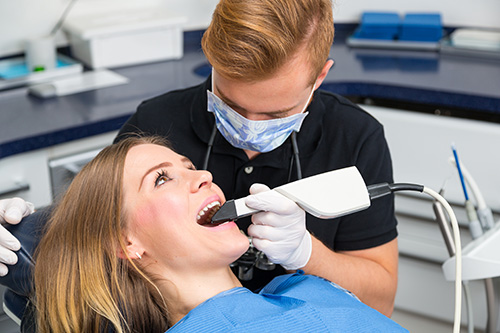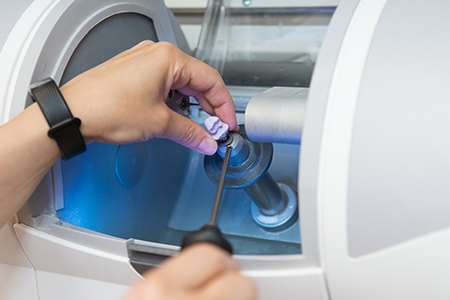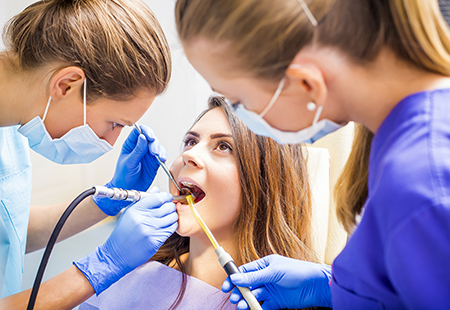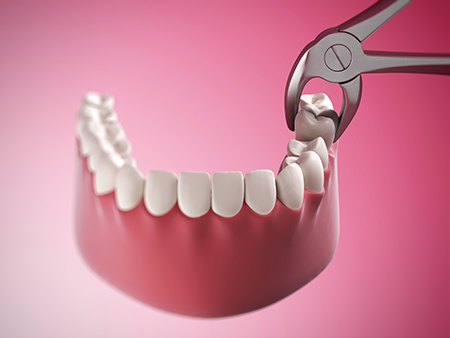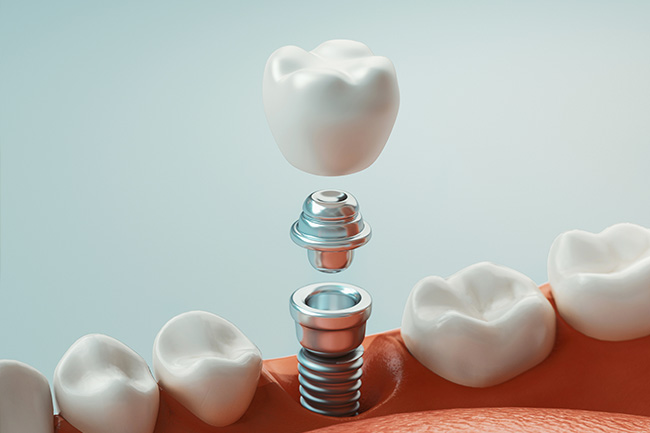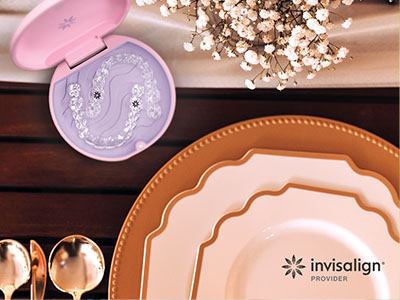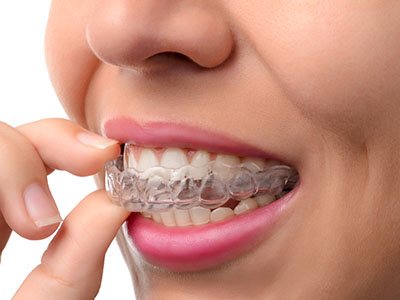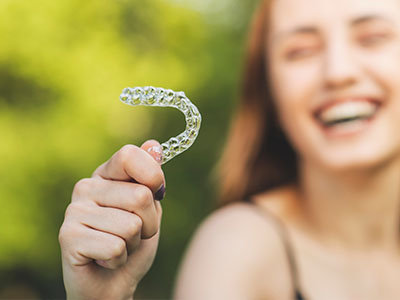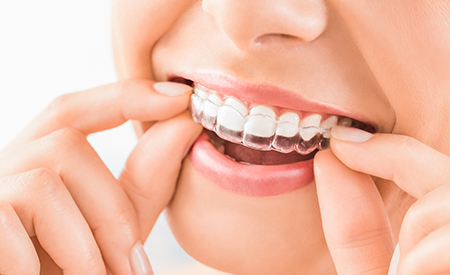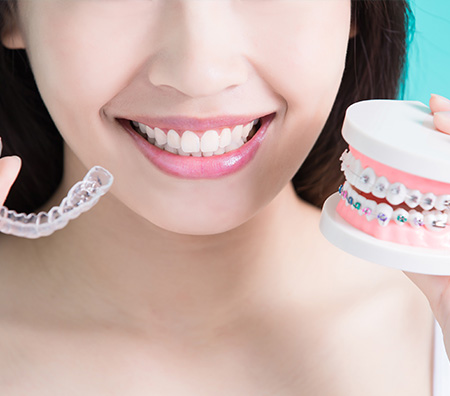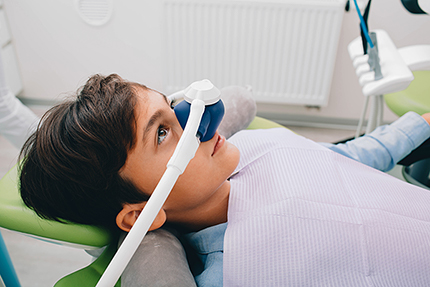Orthodontic Treatment
A healthy, functional, and attractive smile requires teeth that are straight and jaws that are well aligned. While some people have a naturally well-aligned smile, many seek orthodontic treatment to correct overcrowded teeth, a gapped smile, or teeth that have drifted out of position due to extractions, harmful oral habits, and abnormal bite patterns. In some cases, orthodontic treatment goes beyond moving the teeth into their correct positions. Orthodontic care can also address the cosmetic and functional problems associated with skeletal discrepancies between the upper and lower jaws.
Orthodontic treatment utilizes customized appliances to apply controlled, incremental forces that gently move the teeth into proper alignment. While conventional metal braces were once the only option in care, patients today have several choices. Thanks to advances in technology and innovations in care, a wider selection of treatment systems is available. These days, orthodontic appliances are far less bulky, much less noticeable, and more comfortable than earlier generations of braces.
The type of orthodontic treatment and the length of time a patient undergoes care varies, depending on the nature of the case. Orthodontic treatment ranges from the minor movement of a single tooth to the alignment of an entire bite. Although certain corrections can be achieved in a few months, more extensive ones can take a couple of years.
At the office of Tranquil Dental, we understand all aspects of oral health and the cosmetic requirements of a beautiful smile. We’re passionate about what we do and remain dedicated to helping every patient enjoy the benefit of a great looking and healthy smile. We offer a comprehensive selection of dental services to help both adults and children improve the alignment, appearance, and health, of their smiles.
The Importance Of A Well-Aligned Smile
There’s more to a straight smile than the sheer beauty of it. Well-aligned teeth support good oral health, optimal jaw function, and contribute to your overall well-being. Although every smile is different, the potential consequences of teeth that are either overcrowded, have spaces between them, have shifted, or don’t come together in an ideal way remain the same.
Here are some reasons why a well-aligned smile is more than just an attractive asset:
-
Straight teeth are easier to keep clean. Simply put, it’s easier to brush and floss your teeth. With fewer inaccessible nooks and crannies for food to get trapped, your risk of tooth decay and gum disease is lower.
-
Teeth that meet correctly and are not crowded, stick out, or protrude, are protected, as they should be by the lips and soft tissues surrounding the mouth. They are less vulnerable to trauma, getting “knocked out” or damaging fractures.
-
Straight teeth make all manner of oral function easier. The result is that you can bite into your food, chew, and speak, without difficulty or impediment.
-
Teeth and jaws that are well-aligned mean less wear on the teeth. When teeth don’t line up or meet as they should, they often exhibit uneven and excessive areas of wear.
-
A good bite supports temporomandibular joint health and function. A less than ideal occlusion can affect your oral function and comfort. TMJ disorders are associated with a wide range of problems, including headaches, jaw pain, difficulty opening and closing your mouth, as well as other types of head and neck pain.
-
With good oral health and well-being mutually dependent upon each other, a well-aligned smile is essential to overall wellness.
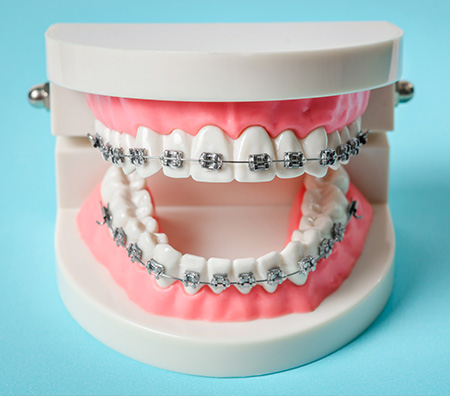
What Type Of Braces Are Right For Your Smile?
At the office of Tranquil Dental, we provide integrated care to help children and adults enjoy the benefits a well-aligned, beautiful, and healthy smiles. Whether your visit to our practice is for a dental checkup or consultation visit, we’ll assess the look, health, and function of your smile and advise you if orthodontic treatment is right for your smile.
We also keep a very close watch on your child’s developing smile and will let you know the best time for an orthodontic consultation and care. From checking the emergence of the baby teeth, jaw development, and oral habits to the premature loss of a baby tooth and the eruption and alignment of the permanent teeth, we carefully monitor your child’s smile as they grow.
Even though the best time to begin care is as a growing child, the truth is that one is never too old for orthodontic treatment. Today more and more adults choose orthodontic care with successful, healthy, and satisfying treatment outcomes.
However, with all the choices in types of braces and systems of care marketed today, it can often feel confusing which approach is best. Whether or not fixed, conventional braces, aligners, removable appliances, or other care offer the best way to achieve optimal and timely results depends on several factors.
Which type of braces provide an effective approach for achieving healthy, attractive, and stable results depends on several factors, including:
-
The severity of the malocclusion or bite problem
-
The degree of crowding or spacing of the teeth
-
If dental extractions are required
-
The relationship between the upper and lower jaws
-
How long appliances are needed
-
If any additional, supportive appliances are required
-
Patient compliance with oral hygiene, appliance maintenance, and wear
Innovations And Advances in Care
As orthodontic treatment has become more widely available, and the appearance of braces has improved, the number of people getting orthodontic treatment has skyrocketed. Over four million people in the United States alone wear orthodontic braces, with 27% of this number being adults.
In the past few decades, advances in care have facilitated more precise treatment planning with appliances that are less bulky, more efficient, and increasingly cosmetic.
Some of the most notable innovations in care include the following:
-
Smaller and streamlined bracket metal bracket design
-
Clear, cosmetic brackets
-
Self-ligating braces
-
Lingual Braces
-
Clear Aligners
-
3-D Imaging with CBCT
-
Digital Impressions
-
Intraoral Scanners and 3-D Planning Software
-
Temporary Anchorage Devices (TADs
-
Accelerated Orthodontics
Orthodontic Treatment With Clear Aligners
Since their arrival on the scene over two decades ago, clear aligners have revolutionized the delivery of orthodontic care. Continuing to soar in popularity, this innovative method of care offers many patients a more discreet, comfortable, and convenient solution for improving the alignment of their smiles.
Treatment that’s virtually invisible to the outside world
Custom-made to the exact specifications of a patient’s smile, clear aligners are designed to gently and incrementally move the teeth into their correct positions. As patients swap out one aligner for the next one in the prescribed series, they’re able to witness progressive improvements in their smiles. Best of all, with treatment that is virtually invisible to the outside world, no one but the patient knows they are undergoing orthodontic care.
Now that orthodontic care has entered the age of aligners, more patients are deciding it’s time to straighten their smiles.
By transforming smiles with minimal interference to daily activities, clear aligners allow patients to enjoy eating all of their favorite foods and engage in recreational activities without the fear of breaking their orthodontic appliances or sharp poking wires. Moreover, as the aligners are completely removable, there’s no need to struggle to brush and floss in between orthodontic brackets and wires.
While clear aligner therapy is a solution for every type of malocclusion, orthodontic treatment with this innovative method of care offers an excellent option for many image-conscious teens and adults.
At the office of Tranquil Dental, we maintain a position at the forefront of advances in care to provide patients with the highest quality services. Whether you are a candidate for treatment with clear aligners, or another method of orthodontic care, we’ll help you achieve a well-aligned and attractive smile.
Orthodontic treatment for children
While some children require early intervention or an initial phase of care, most youngsters begin orthodontic treatment between the ages of 9 and 14. At this time, they are generally in the mid to late mixed dentition stage. This means they have a mix of permanent front teeth, permanent molars, and some baby teeth.
The benefit of placing braces at this stage is that the orthodontist can improve the alignment of permanent front teeth, guide the incoming new adult teeth into position, and utilize the child’s growth and development to the best advantage.
Braces are generally worn for one to three years with an average treatment time of two years. If a child requires a space maintainer, habit control therapy, or exhibits significant jaw disharmony, treatment may begin earlier.
After orthodontic appliances are removed retainers are worn for a period of time to stabilize and maintain the results.
For adults seeking orthodontic care
With the wide variety of orthodontic treatment options available to adults, the process of wearing braces is more convenient, more comfortable, more efficient, and much less conspicuous than ever before. Bulky metal braces are truly a thing of the past. The latest generations of metal appliances are substantially smaller and less unsightly than their predecessors. Moreover, an adult interested in orthodontic care can select braces that are hardly visible at all. Today’s tooth-colored ceramic braces, lingual braces, or removable clear aligners can all effectively deliver treatment to achieve successful and pleasing outcomes of care.
For adults seeking orthodontic care, it’s essential to keep in mind that achieving a successful outcome relies on healthy teeth and supporting bone. Adults seeking treatment sometimes exhibit the damaging consequences of uncorrected bites and poorly aligned teeth. Because their teeth are so jumbled and hard to clean, they may have extensive dental decay, display signs of gum disease, exhibit bone loss, or even had extractions. They may also suffer from worn-down teeth or TMJ joint dysfunction.
While it’s critical to address outstanding dental issues before the start of orthodontic care, it’s also important to continue maintaining the health of the teeth and surrounding tissues both during and following treatment.
Although adult orthodontics requires an investment of time and resources, the payoff is well worth it. The value of a healthy and attractive smile is priceless. Thanks to modern orthodontics, having teeth that look good and function well is something that can be enjoyed at any age.
Maintaining A Beautiful Smile
Everyone who has worn orthodontic appliances can attest that the day their braces or appliances are removed is a happy and gratifying time. Achieving a beautiful, well-aligned, and functional smile is the ultimate reward for having made a commitment to orthodontic care.
Almost every individual who has undergone orthodontic care will need to wear some type of retainer for a prescribed period of time. Retainers help to protect the teeth from relapse.
One of the reasons retainers are needed is because the teeth have a tendency to move back towards their original positions. The delicate fibers connecting the teeth to the jawbones have elastic memory. Once orthodontic appliances are removed, these fibers want to rebound to their natural positions and move the teeth out of their new alignment. Wearing retainers allow these fibers to reorganize in their new positions and to reset their memory.
Retainers are also extremely important because the teeth are part of a complex masticatory system and subject to forces that cannot always be predicted or controlled. Even after orthodontic treatment, any number of things such as tongue or lips postures, unfavorable growth of the jaws, oral habits, and periodontal problems can disrupt teeth alignment.
Remember, the benefits of orthodontic treatment can last a lifetime. Committing to wearing retainers is the best way to preserve your smile and to keep your teeth as straight and beautiful as the day your braces were removed.
FAQs
+When should my child get evaluated for orthodontic care?
Most parents wonder when is the best time to have their child evaluated for braces. One common misconception regarding orthodontic treatment for children is to wait until all of the permanent teeth (with the exception of the wisdom teeth) are present. This belief is not the case. Most problems involving the alignment of your child’s teeth and jaw growth are identifiable by the time your little one is in the first or second grade. That is why the American Association of Orthodontists recommends that all children have a checkup with an orthodontic specialist no later than age 7.
+How long do you have to wear braces?
It is important to keep in mind that aligning the teeth and the jaws does not happen overnight. Whether you are wearing conventional braces, clear aligners, or any other type of appliance, orthodontic movement is a gradual process. Orthodontic tooth movement is based on the use light and continuous forces to correct your bite in an incremental, predictable, and healthy manner.
The total duration of orthodontic care, not including wearing retainers to maintain the result, depends on a number of factors. Treatment time can be influenced by such factors as growth as well as your compliance with care. On average comprehensive orthodontic care to correct a malocclusion can take anywhere between 18-36 months. Orthodontic treatment for more limited problems with tooth alignment typically ranges from 6 to 18 months.
+How often do you need to be seen after your braces are placed?
Because orthodontic movement takes time, most appointments after the initial placement of appliances are scheduled approximately four to eight weeks apart. This interval gives your teeth time to move at both a steady and healthy pace. However, there may be situations where more frequent visits to evaluate the status of your case, tooth movement, or to have a special adjustment are required.
+Can adults wear braces?
Empowered by the knowledge that one is never too old to have orthodontic care, greater numbers of adults are actively seeking treatment for either crooked teeth or jaw problems, as well as to address teeth that have shifted over time due to extractions, habits, or abnormal bite patterns.
Teeth can be moved at any age. Orthodontic treatment as an adult can completely transform an imperfect and poorly aligned smile into one that is attractive and functions well. However, initiating orthodontic care and achieving a successful outcome relies on the presence of healthy teeth and supporting bone. For these reasons, it is important for adult patients to address any outstanding dental problems before their appliances are placed and to be diligent in maintaining their oral health throughout care.
+How much do braces cost, and does dental insurance cover treatment?
Enjoying the benefits of a well-aligned smile often means investing in orthodontic care. With that said, the cost of treatment can vary. It all depends on the extent and type of treatment required to align the teeth and correct the malocclusion. Many dental insurance plans provide some coverage for orthodontic treatment for children under the age of 18 years. To help with any out-of-pocket expenses or to cover the entire cost of care in the absence of dental insurance benefits for treatment, payment plans and financing are available.
Frequently Asked Questions
Most parents wonder when is the best time to have their child evaluated for braces. One common misconception regarding orthodontic treatment for children is to wait until all of the permanent teeth (with the exception of the wisdom teeth) are present. This belief is not the case. Most problems involving the alignment of your child’s teeth and jaw growth are identifiable by the time your little one is in the first or second grade. That is why the American Association of Orthodontists recommends that all children have a checkup with an orthodontic specialist no later than age 7.
It is important to keep in mind that aligning the teeth and the jaws does not happen overnight. Whether you are wearing conventional braces, clear aligners, or any other type of appliance, orthodontic movement is a gradual process. Orthodontic tooth movement is based on the use light and continuous forces to correct your bite in an incremental, predictable, and healthy manner.
The total duration of orthodontic care, not including wearing retainers to maintain the result, depends on a number of factors. Treatment time can be influenced by such factors as growth as well as your compliance with care. On average comprehensive orthodontic care to correct a malocclusion can take anywhere between 18-36 months. Orthodontic treatment for more limited problems with tooth alignment typically ranges from 6 to 18 months.
Because orthodontic movement takes time, most appointments after the initial placement of appliances are scheduled approximately four to eight weeks apart. This interval gives your teeth time to move at both a steady and healthy pace. However, there may be situations where more frequent visits to evaluate the status of your case, tooth movement, or to have a special adjustment are required.
Empowered by the knowledge that one is never too old to have orthodontic care, greater numbers of adults are actively seeking treatment for either crooked teeth or jaw problems, as well as to address teeth that have shifted over time due to extractions, habits, or abnormal bite patterns.
Teeth can be moved at any age. Orthodontic treatment as an adult can completely transform an imperfect and poorly aligned smile into one that is attractive and functions well. However, initiating orthodontic care and achieving a successful outcome relies on the presence of healthy teeth and supporting bone. For these reasons, it is important for adult patients to address any outstanding dental problems before their appliances are placed and to be diligent in maintaining their oral health throughout care.
Enjoying the benefits of a well-aligned smile often means investing in orthodontic care. With that said, the cost of treatment can vary. It all depends on the extent and type of treatment required to align the teeth and correct the malocclusion. Many dental insurance plans provide some coverage for orthodontic treatment for children under the age of 18 years. To help with any out-of-pocket expenses or to cover the entire cost of care in the absence of dental insurance benefits for treatment, payment plans and financing are available.



